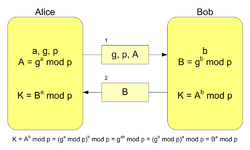X.1035
| Password-authenticated key exchange (PAK) protocol | |
 | |
| Status | In force |
|---|---|
| Year started | 2007 |
| Latest version | (09/07) September 2007 |
| Organization | ITU-T |
| Committee | Study Group 17 |
| Website | http://www.itu.int/rec/T-REC-X.1035 |
ITU-T Recommendation X.1035 specifies a password-authenticated key agreement protocol that ensures mutual authentication of two parties by using a Diffie–Hellman key exchange to establish a symmetric cryptographic key. The use of Diffie-Hellman exchange ensures perfect forward secrecy—a property of a key establishment protocol that guarantees that compromise of a session key or long-term private key after a given session does not cause the compromise of any earlier session.
In X.1035, the exchange is protected from the man-in-the-middle attack. The authentication relies on a pre-shared secret (e.g., password), which is protected (i.e., remains unrevealed) to an eavesdropper preventing an off-line dictionary attack.[1]
The protocol can be used in a wide variety of applications including those with pre-shared secrets based on possibly weak passwords.
X.1035 was approved on 13 February 2007 by ITU-T Study Group 17.[2]
Applications
G.hn, an ITU-T standard that specifies high-speed (up to 1 Gbit/s) local area networking over existing home wires (power lines, phone lines and coaxial cables), uses X.1035 for authentication and key exchange.
References
- ↑ Andreasson, Kim J. (2012-05-17) (in en). Cybersecurity: Public Sector Threats and Responses. CRC Press. pp. 151. ISBN 9781466551237. https://books.google.com/books?id=isU3ewATX3QC&pg=PT151.
- ↑ "X.1035 : Password-authenticated key exchange (PAK) protocol". https://www.itu.int/rec/T-REC-X.1035.
 |

